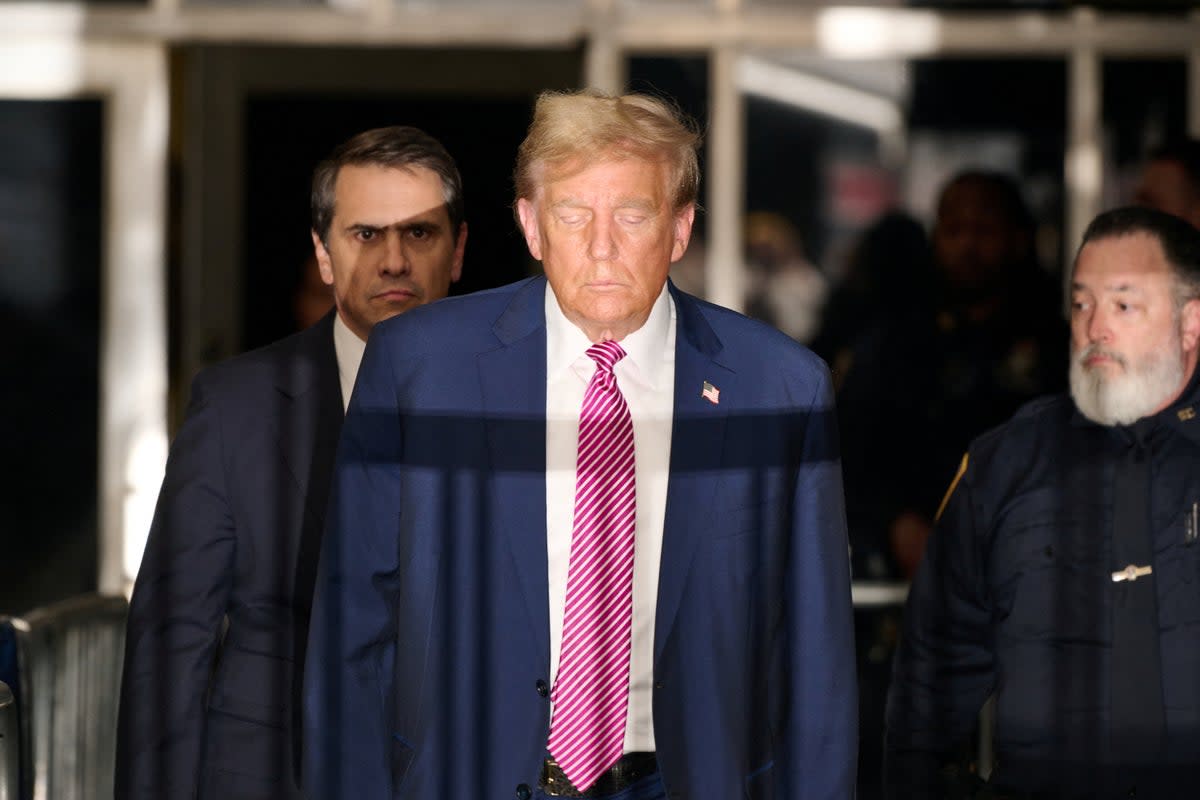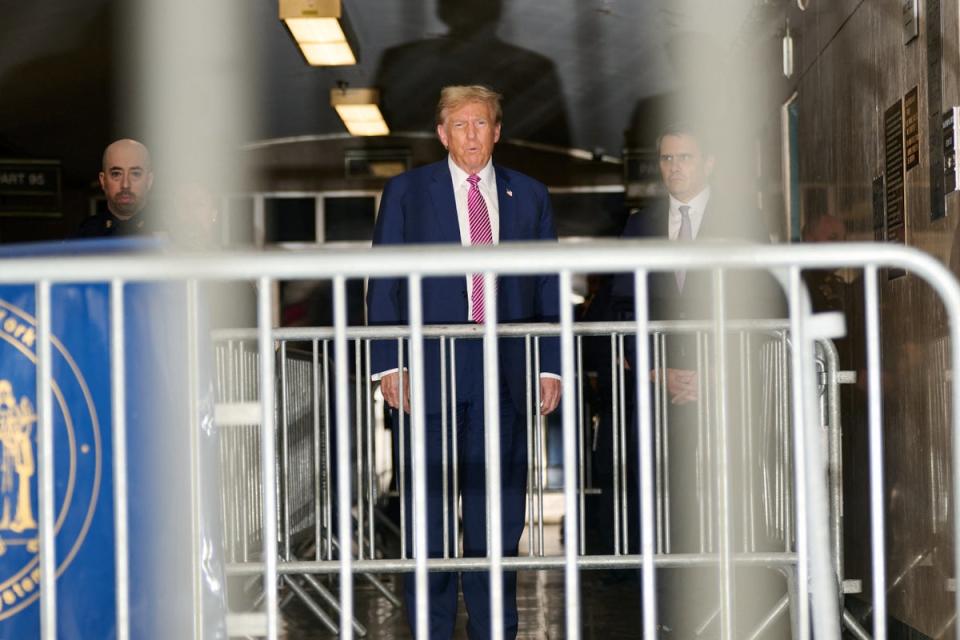Outside court, Trump tries to command the narrative. Inside, he can only sit in silence

The city of New York is “crime-ridden and dying,” according to Donald Trump. He has called a criminal case against him a “mess,” the judge hopelessly “conflicted,” and the prosecutor a “thug.” The former president’s attorneys claim that the entire borough of Manhattan is “overwhelmingly biased” against him.
But for four days, a few dozen of his fellow New Yorkers told him how they felt, to his face, and there was nothing he could do about it.
A jury of Mr Trump’s peers has been assembled to hear the first criminal trial of a current or former president, who is charged with falsifying business records to conceal payments to an adult film star with whom he allegedly had an affair.
Hiding those payments tried to protect his election prospects in 2016, the beginning of what has now become a years-long effort to deceive voters and manipulate the outcome of a presidential election, according to prosecutors.
He loves his New York business, his New York real estate and the New York media that has his attention, but Mr Trump for years now has become more Florida man than the self-anointed bootstrapped Queens entrepreneur he propped himself up to be as he built his political persona.
This week, the former president returned to New York as a reluctant resident of his hometown, watching the group of his Manhattan neighbours fill the jury box where a verdict against him could be delivered in a few weeks.
The jurors live all over Manhattan, with different professional backgrounds, genders, interests and family lives. All have promised, unlike Mr Trump, to judge their fellow New Yorker fairly and impartially.
When his attorneys dug up prospective jurors’ old social media posts to try to weed out potential bias, Mr Trump heard himself described as racist, sexist and a narcissist.
Asked for her opinion of him, one juror to his face called him “selfish” and “self-serving.” Another man called his policies “outrageous.” One man’s opinion of him is “neutral, leaning hostile.” Another said his rhetoric is “harmful,” and one woman said his rhetoric incites homophobia and racism.
All he could do was sit and watch.
He never looked comfortable. He rested his hand on his forehead with his elbow on the table, turning his body to look at the jury box to his right. He twisted his body and craned his neck. He leaned forward in his chair, reading along with a jury questionnaire or titling back in his seat and pulling the survey close to his face.
He barely moved for more than an hour, shoulders tight and leaning forward against the table in front of him, while one of his attorneys argued against prosecutors’ drudging up past allegations of fraud and sexual abuse.
When his attorneys and prosecutors shared a laugh about a busted microphone, he sat stone-faced. When a juror said the former president was not her “cup of tea,” he huffed, shook his head, crossed his arms tightly and leaned in his chair.
It took less than two days for the judge overseeing the case to warn Defendant Trump against intimidating the jurors before him when he was caught “gesticulating” and “audibly” commenting about one of the jurors.
“I won’t tolerate it. I will not have any jurors intimidated in this courtroom,” Judge Merchan told him on Tuesday. “I want to make that crystal clear.”

It served as a warning for the trial to come. Mr Trump is forced to attend every day of his criminal trial, which is shaping up to become the climax of his years-long assault on the justice system, which he has broadly and baselessly accused of conspiring against him to keep him out of the White House. Prosecutors have accused him of repeatedly intimidating witnesses and violating a gag order that prohibits his public attacks against members of the court and their families. He has said it would be a “great honor” to go to jail for doing so.
He is not only a criminal defendant but a presidential candidate prepared to weaponise his massive social media and campaign apparatus and use his platform to wield the trial’s narrative. The proceedings are not filmed or recorded, but a small army of reporters will fill two courtrooms to capture as much as they can. To his followers, Mr Trump pits his word against those he has described as the “enemy of the people.”
Two already-seated jurors were excused after they shared concerns with the judge about their identities being released. Several potential jurors were excused after openly weeping in court, sharing their anxieties and the immense pressure they felt sitting in the jury box.
On Wednesday night, one day after seven jurors were sworn in, Fox News personality Jesse Watters broadcast identifying details about a woman who was initially Juror No 2.
He claimed without evidence that “undercover liberal activists” were trying to get on the jury.
Mr Trump then quoted his statement on Truth Social, raising baseless speculation that Manhattan residents called to jury duty are lying to the judge, prosecutors and defence attorneys so they can be seated in the case – elevating his bogus conspiracy theory that the cases are “rigged” against him.
The next morning, Juror No 2 returned to court to tell the judge that aspects of her identity across the media prompted friends, colleagues and family members to ask her about the case.
“I don’t believe, at this point, that I can be fair and unbiased, and let the outside influences not affect my thinking in the courtroom,” she said on Thursday.
Moments later, Manhattan prosecutors alerted the judge to Mr Trump’s “disturbing” Truth Social post quoting Watters, which appeared on the former president’s social media platform just one day after the judge warned him against intimidating jurors.
“It’s ridiculous, and it has to stop,” Assistant District Attorney Christopher Conroy told the judge on Thursday.

Mr Trump has violated a protective order in the case at least seven more times since the trial began, according to prosecutors.
On his program on Thursday, Watters claimed that Juror 2 “dropped out because she couldn’t be impartial,” then falsely stated that another juror who was excused “ended up being a stealth juror” – baselessly asserting that he was politically motivated to join the jury to convict Mr Trump.
On Thursday, prosecutors said they were declining to hand Mr Trump’s lawyers the names of the first three witnesses they intend to call to the stand, fearing what the former president could do with that information.
“Mr Trump has been tweeting about the witnesses,” Mr Steinglass told the judge. “We’re not telling him who the witnesses are.”
“I can’t fault them for that,” Judge Merchan replied.
Defence attorney Todd Blanche suggested that he would stop Mr Trump from doing that.
“I don’t think you can make that representation,” the judge said.
On Friday, moments before Judge Merchan adjourned for the week, Mr Trump’s attorney Susan Necheles asked for the name of at least one witness.
“Whether you get the name or not, you’re not going to delay the trial,” Judge Merchan told her. “You won’t.”
Prosecutors intend to name on Sunday the name of at least one witness who could testify as early as next week, but if Mr Trump posts anything about that person, the deal is off.
Mr Trump’s time-tested legal strategy – throw everything at the court to buy time – has failed. The trial is underway. Jurors will be seated. Witnesses are being scheduled. Within a few weeks, a verdict could be reached.
“Defence cannot continue to submit premotion letters, or motions, or requests to reargue, or for the court to reconsider, every single decision,” Judge Merchan told Mr Trump’s attorneys on Friday.
“Defence is literally targeting individual decisions one by one by one by one,” he added. “That has to end ... There comes to a point where you accept my rulings ... I’ve entertained your motions. I’ve entertained your arguments in good faith.”
With the day’s proceedings at a close, Mr Trump – surrounded by the most reporters who have been in the courtroom since the start of the trial – slowly stood up from his seat at the defence table, scanned the room, and trudged his way to the door.
His campaign then sent out an email, falsely declaring for the second time that week that he “stormed out.”


